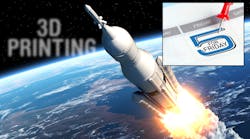1. New Heights For 3D Printing
There’s a new dimension to space exploration. Actually, it’s three dimensions.
Students from the University of California Berkeley used 3D-printed parts in developing a bi-propellant liquid-fueled rocket. The first-of-its-kind rocket, developed by Cal’s Space Enterprise Berkeley team, in December launched a rocket more than 11,000 ft, becoming the first collegiate rocketry team to pass the Karman line dividing Earth’s atmosphere and outer space. A new Machine Design article discusses the value of using 3D-printed parts to develop the plenum and parachute systems.
As part of a collaborative program with Protolabs, students found the value in using 3D to design and develop the system components. “It’s just a lot faster to iterate on them than it would be if we were making them out of aluminum on a CNC machine or something of that matter and we didn’t have to make any compromises on the design,” said student Asa Garner. “It’s been very convenient to utilize (3D) printed parts on the rocket.”
2. Cooling With Less Energy Use? No Sweat
I generally love summer. I live in the Chicago area, and when it’s hot outside, I remind people that you don’t have to shovel sunshine. But it was 100 degrees this week with heat indexes approaching 110, and in that weather, you’re looking to stay cool at all costs.
A new Machine Design article by Editor-in-Chief Rehana Begg explains that the cost of keeping cool in an age of global warming and high energy costs can be achieved with less power and more passive cooling, which utilizes technologies or design features that lower the temperature in spaces without the need for power consumption.
In one of the more interesting examples, Washington State University researchers designed a 60-sq-ft chamber to test passive systems. Their prototype uses the combined effects of wind towers and water evaporation instead of electricity to cool spaces.
3. Different Links in the Supply Chain
My wide-ranging discussion with MxD CEO Berardino Baratta on the evolution of the modern supply chain will be part of a webinar sponsored by Fabco-Air on Sept. 1 at 11 a.m. EST. Among the topics we tackle in this webinar:
- What’s the current state of the supply chain? How have manufacturers and suppliers addressed the systemic failures of the past two years?
- How do technologies such as motion control, sensors and vision systems work together to deliver improved efficiency and pick accuracy on plant floors?
- How do manufacturers better secure their supply chain data to ensure data flows smoothly and swiftly to improve productivity while minimizing the threat of cyberattacks?
It’s a great discussion, and it will offer some fresh thoughts on the best ways to ensure supply chain stability for the future.
4. Data Loggers and Predictive Maintenance
Sensors are a key component in almost every aspect of manufacturing. That value is only as good as the sensor itself—a point made in a new Machine Design article.
Author Emily Newton writes that you need to make sure the sensors are properly calibrated at regular intervals. “An effective PdM strategy must include data logger calibration steps,” Newton writes. “As more businesses start to rely on predictive maintenance, ensuring it delivers solid returns becomes increasingly important. Maximizing these returns on investment means paying more attention to data loggers and their calibration needs.”
5. The Power of Lasers
We’ve shaken most of the sci-fi mythology out of lasers; they now are vital tools in so many operations. One such area is quality control, and a new Machine Design article talks about the many ways lasers can be used to drive productivity and reduce errors. “Some products on the market capture more than a million data points per second, making them much faster than what people could achieve,” the article notes. “Humans play an essential role in verifying what the laser-measuring devices indicate and flagging any problems that arise.”
